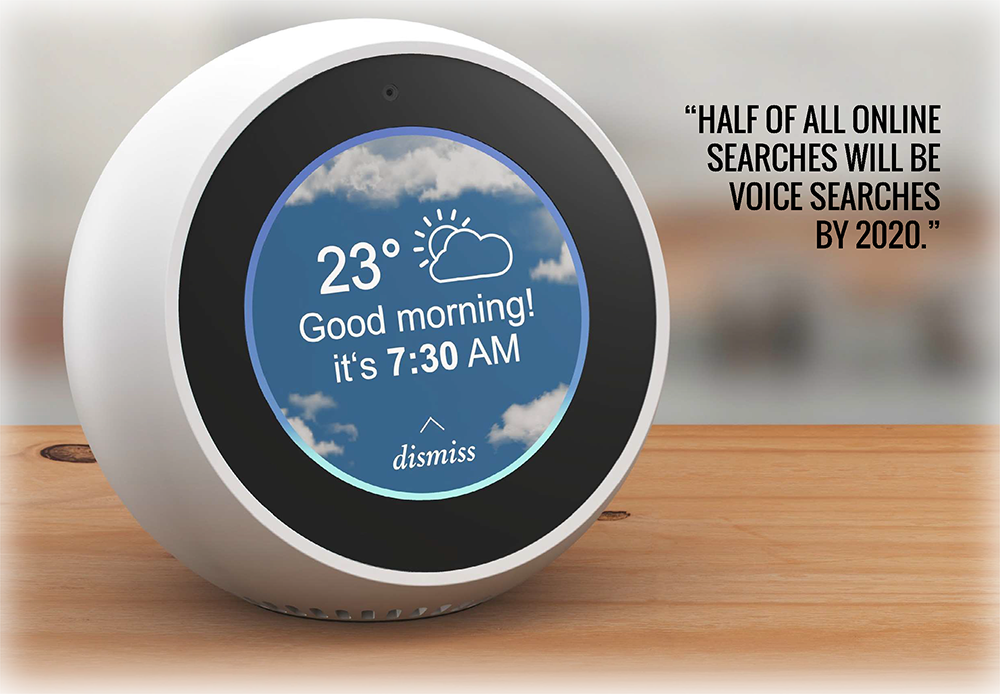
Voice search is everywhere these days. You’ve heard about it before, but it’s long past time to think of it is something to worry about in the future. The future is now.
As of 2019, 20% of all Google searches are voice-activated – a number that’s expected to leap to 50% as early as 2020.
The statistics around voice-enabled gadgets like Siri, Alexa, and Cortana, are even higher. Only 18% of US households owned one as of 2018. By 2022, it’ll be 55%.
What’s that tell us? Voice search is here to stay. It’s growing – and businesses who don’t embrace it now are going to be
left scrambling in the very near future.
Your challenge, should you choose to accept it, is to embrace voice search and recognize that optimization is not optional. Here’s what you need to know.

There are two key differences between voice search and traditional text-based searches. Understanding them is a must if you want to capitalize on voice search and grab your share of traffic and sales.
The biggest difference is one that illustrates why
the growing trend of voice searches isn’t something to take lightly.
With traditional search, you can grab a share of the organic traffic from the SERP even if you’re not ranked number one. Why? Because searchers don’t always click on the first link.

They’ll scroll, skim titles and meta descriptions, and choose the link that best suits their needs. Even if you’re tenth – or on the second page of search results – you can still get a few clicks out of the deal.
Voice search is a different thing entirely. When someone searches a keyword or asks Siri a question, they’re not getting a list of results. The virtual assistant reads one – and only one —
result. In other words, in the world of voice search, if you snooze, you lose!
The second key difference between voice and text search is the keywords that dominate. Google’s been prioritizing long-tail keywords for all searches, but in voice search, there’s no other option.

As you probably expected, Google keeps its voice search algorithm secret. However, there are some ways to improve your chances of ending up in the featured spot – the coveted position where your site is the one being offered as the solution to a search request.
#1: Answer a Question
A lot of voice searches are worded as questions. Answering the most commonly-asked questions can help you move
up the SERP to the featured position.
Not sure what questions to answer? You can try using Answer the Public, a site that generates questions based on the keywords you enter.
Here’s a sampling of the suggested questions for Facebook advertising:
- How does Facebook advertising pricing work?
- What are Facebook advertising policies?
- Is Facebook advertising taxable?
To grab the lion’s share of traffic for these questions, the best method is to make the question itself an H2 tag in your content.
Then, answer it as clearly and concisely as possible immediately under the H2. Google’s always going to prioritize quality content. Getting right to the point in a way that’s engaging will help Google see your response as the best answer.

#2: Optimize for Long-Tail Keywords
A lot of businesses are accustomed to optimizing for short keywords. Those days are over. Long-tail keywords are the name of the game. They’re more conversational and contextual than old school keywords. They’re also the keywords most likely to be used in voice searches.
Ever since Google released its Hummingbird update in 2013, the emphasis has been on long-tail keywords. To maximize your traffic from voice search, you’ll need to identify the most likely search terms and highlight them in your content.
One of the easiest ways to identify long-tail keywords is to scroll down to the bottom of the Google SERP after doing a search and check out the “People Also Ask” box, which lists questions that are commonly asked along with what you searched. It’s a great way to identify variations and pinpoint the terms people are using to search.
#3: Optimize for Local Searches
You might be tired of hearing about local search, but the truth is that it’s more important than ever. 76% of all voice search users use it for local searches at least once a week, and 53% make local searches daily.
If you haven’t standardized your NAP listings, optimized your site for local keywords, claimed your review listings, and optimized your Google My Business listing, you’re probably not going to perform well in voice search.
Make sure that all business data is accurate, including your hours of operation, address, and any other information that might be relevant to searchers.
#4: Use the Right Words
It might shock you to know that approximately 20% of all voice searches are triggered by the same 25 words.
These include words like:
| – How | – What |
| – Best | – Where |
| – Top | – New |
| – Define | – Types |
Focusing your content on these words can help you jump ahead of your competitors and grab more than your share of voice search traffic.
The key is to incorporate the right words into content that answers questions, using the proper tags and markers to ensure that Google can read and index your content correctly.

#5: Speed Up Your Site
Voice searchers expect to get search results nearly instantaneously. In fact, one study found that a site that took just 5 seconds to load was 90% more likely to get a bounce than a site that took only one second to load.
Complicating matters is the fact that mobile searches have a bounce rate that’s nearly 10% higher than desktop searches.
Maximizing your site’s speed increases the chances that you’ll move to the top in voice search. A slow-loading site is not going to be Google’s first choice. Remember, their goal is always to deliver the most relevant site to the searcher as quickly as possible.
Voice search is coming for all of us – and you can’t afford to ignore it. SEO is never an exact science, but the tips here can help make your content what Google voice searchers want – and increase the chances that you’ll land the coveted top spot.
Want to Know How Well You’re Optimized For Voice Search?
Click Here For a Complimentary Analysis!

